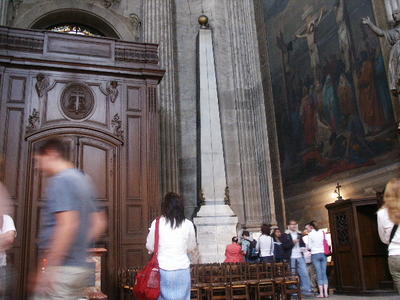


But next to the obelisk was small pamphlet describing the purpose of the "gnomon":
The brass line on the floor of this church and continued on the obelisk against the wall forms part of an "astronomical gnomon" built here in 1743.
This scientific instrument comprises:
-- the meridian line precisely oriented north/south,
-- a small aperture in the metal plaque on the right-hand upper side of the opposing window.
It has never been called a "Rose Line".
It is not the vestige of an ancient pagan temple. No such edifice ever existed on this site.
It has never been used to define the "prime meridian," a role now played by the Greenwich meridian....
The flier goes on the say that at noon solar time each day, the rays of the sun would project a disc of light at a different point along the line every day, and that the gnomon was used "to ascertain various parameters of the earth's rotation" and "to check the calculations made in the 16th century ... for the adoption of the Gregorian calendar," and that it was "also intended th help determine the exact time, and to relay it to Paris by the toll of bells."
So here we have a serious factual disagreement between the prologue of The Da Vinci Code which, although I don't have it here, I recollect saying something to the effect that 'every single fact in this book is completely true and accurate' (although exactly what that means in a book of fiction is a fair question), on the one hand, and the folks at St. Sulpice, on the other. Now let's see, who should I believe here, an author who wants to make money by selling books, or the priests at St. Sulpice? Well, I suppose the priests could be despritely trying to cover up their church's unsavory pagan past, but somehow I doubt it. Also, a bit of quick research on the Internet reveals that although France did have its own "prime meridian," as did many other countries, it is uncertain whether it ran through St. Sulpice:
France clung to the Paris meridian (now longitude 2º20 east) as a rival to Greenwich until 1911 for timekeeping purposes and 1914 for navigation. When other world powers agreed on Greenwich as the prime meridian in 1884, France abstained. Typical “French exception” mentality, you might think — but France had practically invented the modern science of earth measurement, and thus had a very decent claim to the prime position.
A French astronomer, Abbé Jean Picard, had been the first to measure the length of a degree of longitude and from it compute the size of the Earth, in 1655. This feat in turn was instrumental in the siting of the Paris Observatory: on Midsummer’s Day 1667, members of the newly formed Academy of Sciences traced the future building’s outline on a plot outside town near the Port Royal abbey, with Picard’s meridian exactly bisecting the site north-south.
Another web site describes how dearly the French wanted to keep their own prime meridian:
The Greenwich Meridian was chosen as the Prime Meridian of the World in 1884 at the International Meridian Conference, where forty-one delegates from 25 nations met in Washington DC. By the end of the conference, Greenwich had won the prize of Longitude 0º by a vote of 22 to 1 against (San Domingo), with two abstentions (France and Brazil). Algeria, a French dependent, objected to the phrase "Greenwich Mean Time" and proposed "Paris Mean Time diminished by 9 mins 21 secs" instead.
My conclusion: No Rose Line in St. Sulpice, just an Astronomical Gnomon.




No comments:
Post a Comment